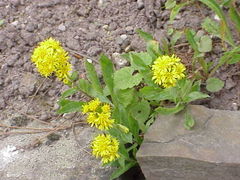Solidago virgaurea: Difference between revisions
No edit summary |
No edit summary |
||
| (One intermediate revision by one other user not shown) | |||
| Line 2: | Line 2: | ||
|familia=Asteraceae | |familia=Asteraceae | ||
|genus=Solidago | |genus=Solidago | ||
|species=virgaurea | |species=virgaurea | ||
|taxo_author=L. | |||
|common_name=Goldenrod, Aaron’s Rod | |||
|habit=herbaceous | |habit=herbaceous | ||
|habit_ref=Flora - A Gardener's Encyclopedia | |habit_ref=Flora - A Gardener's Encyclopedia | ||
| Line 11: | Line 13: | ||
|Max wd metric=in | |Max wd metric=in | ||
|width_ref=Flora - A Gardener's Encyclopedia | |width_ref=Flora - A Gardener's Encyclopedia | ||
|lifespan=perennial | |||
|life_ref=Wikipedia | |||
|exposure=sun, part-sun | |exposure=sun, part-sun | ||
|sun_ref=Flora - A Gardener's Encyclopedia | |sun_ref=Flora - A Gardener's Encyclopedia | ||
| Line 18: | Line 22: | ||
|flowers=orange, yellow | |flowers=orange, yellow | ||
|Temp Metric=°F | |Temp Metric=°F | ||
|image= | |min_zone=5 | ||
|usda_ref=Flora - A Gardener's Encyclopedia | |||
|max_zone=9 | |||
|image=Solidago virgaurea minuta1.jpg | |||
|image_width=240 | |image_width=240 | ||
|image_caption=Solidago virgaurea minuta | |||
}} | }} | ||
'''''Solidago virgaurea''''' ('''goldenrod''' or '''woundwort''') is an [[herbaceous]] [[perennial plant]] of the family [[Asteraceae]]. It is grown as a garden flower with many different cultivars. It flowers profusely in late summer. | |||
{{Inc| | {{Inc| | ||
Solidago virgaurea, Linn. European Goldenrod. A rough simple-stemmed but stout perennial 1-3 ft. high: basal lvs. 4-7 in. long, 2 – 2 1/2 in. wide, obtuse or acute; upper lvs. sessile or narrowed into margined petioles: fls. in a dense terminal, rather narrow and often interrupted thyrsus which is often 8-10 in. long: bracts of the involucre acute or acutish. Eu.—One of the best garden plants of the group. A prostrate form is offered. S. cambrica, Huds., is a compact and dwarf form, 6 in. or less high, with larger heads. S. Virgaurea is represented in the U. S. by S. Cutleri, Fern. (S. Virgaurea var. alpina, Bigel.), in the highest alpine districts of N. New England and N. Y.; this American species appears not to be in the trade. | |||
Solidago virgaurea, Linn. European Goldenrod. A rough simple-stemmed but stout perennial 1-3 ft. high: basal lvs. 4-7 in. long, 2 – 2 1/2 in. wide, obtuse or acute; upper lvs. sessile or narrowed into margined petioles: fls. in a dense terminal, rather narrow and often interrupted thyrsus which is often 8-10 in. long: bracts of the involucre acute or acutish. Eu | |||
{{SCH}} | {{SCH}} | ||
}} | }} | ||
==Cultivation== | ==Cultivation== | ||
===Propagation=== | ===Propagation=== | ||
===Pests and diseases=== | ===Pests and diseases=== | ||
== | |||
==Varieties== | |||
==Gallery== | ==Gallery== | ||
<gallery perrow=5> | |||
<gallery> | |||
Image:Upload.png| photo 1 | Image:Upload.png| photo 1 | ||
Image:Upload.png| photo 2 | Image:Upload.png| photo 2 | ||
| Line 79: | Line 56: | ||
==References== | ==References== | ||
<references/> | |||
<!--- xxxxx *Flora: The Gardener's Bible, by Sean Hogan. Global Book Publishing, 2003. ISBN 0881925381 --> | <!--- xxxxx *Flora: The Gardener's Bible, by Sean Hogan. Global Book Publishing, 2003. ISBN 0881925381 --> | ||
<!--- xxxxx *American Horticultural Society: A-Z Encyclopedia of Garden Plants, by Christopher Brickell, Judith D. Zuk. 1996. ISBN 0789419432 --> | <!--- xxxxx *American Horticultural Society: A-Z Encyclopedia of Garden Plants, by Christopher Brickell, Judith D. Zuk. 1996. ISBN 0789419432 --> | ||
| Line 88: | Line 65: | ||
{{stub}} | {{stub}} | ||
__NOTOC__ | |||
Latest revision as of 00:24, 3 June 2010
| Solidago virgaurea subsp. var. | Goldenrod, Aaron’s Rod | |||||||||||||||||||||||||||||||||||||||||||||||||||||||
|---|---|---|---|---|---|---|---|---|---|---|---|---|---|---|---|---|---|---|---|---|---|---|---|---|---|---|---|---|---|---|---|---|---|---|---|---|---|---|---|---|---|---|---|---|---|---|---|---|---|---|---|---|---|---|---|---|

|
|
| ||||||||||||||||||||||||||||||||||||||||||||||||||||||
| ||||||||||||||||||||||||||||||||||||||||||||||||||||||||
Solidago virgaurea (goldenrod or woundwort) is an herbaceous perennial plant of the family Asteraceae. It is grown as a garden flower with many different cultivars. It flowers profusely in late summer.
| Standard Cyclopedia of Horticulture |
|---|
|
Solidago virgaurea, Linn. European Goldenrod. A rough simple-stemmed but stout perennial 1-3 ft. high: basal lvs. 4-7 in. long, 2 – 2 1/2 in. wide, obtuse or acute; upper lvs. sessile or narrowed into margined petioles: fls. in a dense terminal, rather narrow and often interrupted thyrsus which is often 8-10 in. long: bracts of the involucre acute or acutish. Eu.—One of the best garden plants of the group. A prostrate form is offered. S. cambrica, Huds., is a compact and dwarf form, 6 in. or less high, with larger heads. S. Virgaurea is represented in the U. S. by S. Cutleri, Fern. (S. Virgaurea var. alpina, Bigel.), in the highest alpine districts of N. New England and N. Y.; this American species appears not to be in the trade. CH
|
Cultivation
Propagation
Pests and diseases
Varieties
Gallery
-
photo 1
-
photo 2
-
photo 3
References
External links
- w:Solidago virgaurea. Some of the material on this page may be from Wikipedia, under the Creative Commons license.
- Solidago virgaurea QR Code (Size 50, 100, 200, 500)
